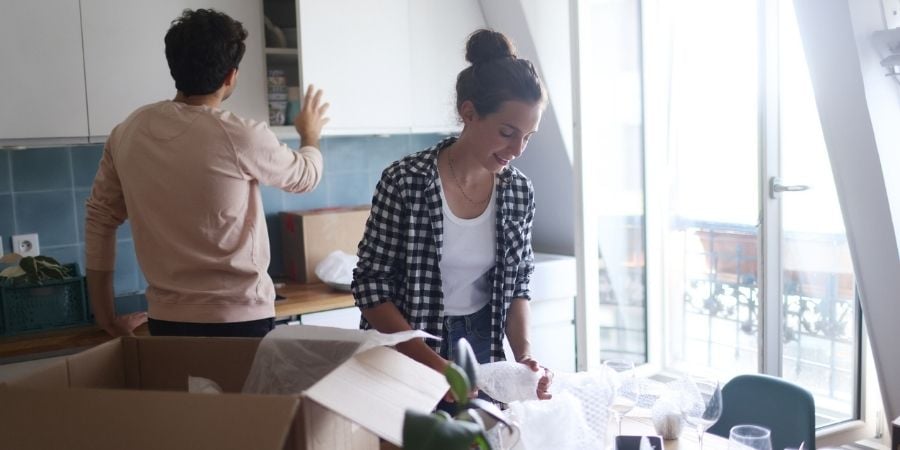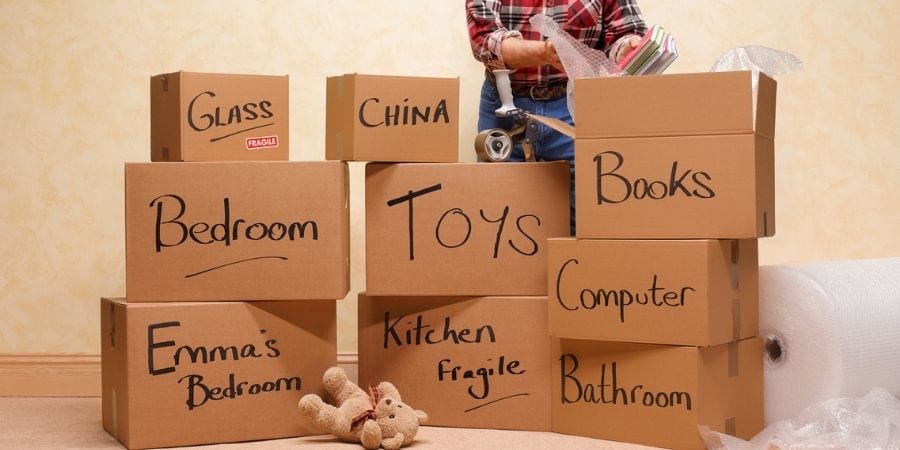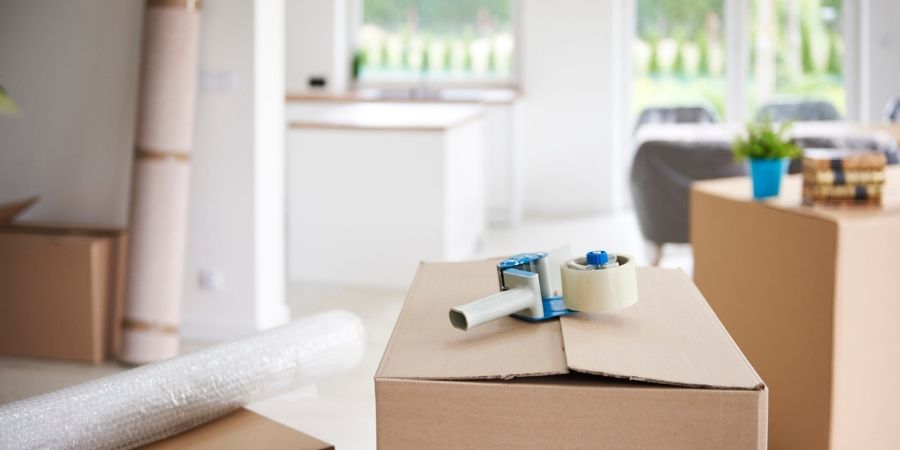Before packing, you should already have your movers or moving company hired and your move-in date settled. We suggest starting with a budget. That way, as you search for professional movers, you’ll have a better idea of how much you’re willing to spend. After you’ve chosen a budget, picked your movers and a date for the move, there’s still plenty to do!
What to do first when packing?
We’ve compiled some suggestions to help you make your packing process the smoothest it’s ever been.
Now is an excellent time to declutter.
Take moving as an opportunity to get rid of some things you never wear or use. What’s the point of bringing that blender with you when you haven’t used it in a year?
Start packing early.
We recommend starting the packing process at least 2-3 months before the move. The more you’re able to pack early on, the less stressed you’ll be in the final weeks of moving.
Gather your supplies beforehand. While you may not know exactly how many moving boxes you’ll need, you should go ahead and gather supplies. It’s better to have a few extra boxes than to have to scramble around the last few days of the move and try to find more.
Take an inventory as you pack. This is an essential part of the moving process, so you know what you’ve packed. Jot down any serial numbers for your electronics before you pack them up. Take pictures, especially of valuables, in case they go missing during the move. Photos and serial numbers will also help if you need to file an insurance claim.


How do you organize items before moving?
Moving is an excellent opportunity to get rid of items you’ve held on to over the years. When you’re doing your initial assessment of what you want to pack, we suggest you consider these questions:
Is it broken but not an easily recyclable item? If so, you should add it to your trash pile and junk it.
Is it still usable but not something you’d wear or use anymore? Consider donating it to a local charity or selling the item.
Is it a paper, glass or plastic item that would be difficult to donate? Recycling it might be your answer.
Do you have a relative or friend that could use it, even if you can’t? Your friends and family might find those old clothes beneficial for their new baby or maybe that bag of dog food Fido never liked could be their pet’s new favorite meal.
Answering these questions will help you decide if you really need those items. Because, ultimately, do you want to spend money packing and moving boxes of things you’ll never use?


Packing to move… where to start?
So, you have your home and a general idea of when you want to move, but you’re not sure what to do next? We’ve created a helpful checklist to get the ball rolling. We know moving can be stressful, but it might be a little less stressful next time if you follow these suggestions.
2-3 months before the move:
Start gathering boxes, either from your friends or from your local grocery store .
Make sure you have all your packing materials, like scissors, boxes, bins and tape.
Pack out-of-season items, like winter coats, beach towels,
Pack infrequently used items, like kitchen supplies or kitchen electronics, barbecue grills and camping gear.
Start listing furniture you don’t want to take with you on Craigslist or Facebook Marketplace. Start planning a garage or yard sale now, if that’s something you want to do.
1-2 months before the move:
Have your garage or yard sale.
Start getting rid of unused items and clothes that are unworn. It’s good to have separate piles for things you want to throw away, recycle, donate or give to friends and family.
Start packing rooms you don’t use a lot, like the guest bedroom, attic or basement.
Pack your home décor and books.
30 days before the move:
Create a meal plan with any remaining food, so you won’t need to pack it when you move.
Make arrangements to donate any furniture you don’t want. You can schedule a pickup with your local Goodwill, the Salvation Amy or Habitat for Humanity.
Start packing items in your closet and kitchen, like extra table settings, shoes and clothes you won’t wear.
Pack your jewelry, valuables and collectibles. For fragile items, consider wrapping them in unused linens for additional protection. This will also reduce the overall boxes you’ll need, too!
Consider donating or recycling your plastic and glass containers, as these items can take up a lot of space and are often affordable to re-buy.
14-30 days before the move:
Donate any remaining non-perishables to your local food bank.
If you’ll need any specific moving day materials like bungee cords or furniture pads
You’ll want to start seriously packing your home now.
7-14 days before the move:
Make backup copies of your computer’s hard drive.
Have a few last-minute boxes and bags on hand for anything that might have gotten missed over the past few months and needs to be packed now.
You’ll want to have your non-essential items packed a week out.
Start putting together an essentials box. This is a box you’ll add anything you’ll need and use within the first few days of your home.
2-7 days before the move:
A week before the move, you should remove all picture hooks, nails or other wall hangings and odds and ends from around the house.
Dismantle any large furniture pieces, electronics and appliances.
Put the finishing touches on your essentials box, so it’s packed and ready to go for moving day.
It’s a good idea to dust, sweep and vacuum as you clear out each room.
What to do the day before the move:
Finish packing a Day-of Essentials bag. We’ll go more into what you should include below.
We also recommend that you pack a First Few Days box, too. It should have kitchen essentials like utensils and coffee, as well bathroom and bedroom necessities like a shower curtain, sheets, pillows and curtains.
Add your passports, birth certifications, a copy of your driver’s license or other necessary documents to a box you’ll take with you in your car. You don’t want these items getting lost in the move.
Unpacking tips for the day of the move:
Put any valuables or sentimental items in the car with you so you know they’re safe.
Before unpacking your other belongings, the first thing you should do is make the bed in your new home. After spending all day unpacking, you might not feel up to it later. Having clean, fresh sheets can help make your first night cozy and comfortable.
If you can’t find your curtains, you can hang sheets for privacy in a pinch.


Start by gathering your moving day supplies.
If you’re packing everything up yourself, you’ll want to purchase your supplies before moving day.
What packing supplies do you need before moving?
Moving boxes (cardboard boxes or plastic boxes); a mix of small, medium and large boxes
Packing tape
Permanent markers
Color-coded stickers or labels
Furniture pads or covers
Toolset for any last-minute item disassembling.
Bubble wrap, packing paper or newspapers.
Self-moving packing supply list:
Cargo straps, bungee cords, or ropes for securing furniture
Dollies or hand trucks (these are especially valuable if you move frequently)
Work gloves to protect your hands as you move items
Back support brace
Vacuum or broom and dustpan
Glass cleaners
All-purpose cleaners
Sponges or paper towels
Cleaning supplies to pack:
Garbage bags
Vacuum or broom and dustpan
Glass cleaners
All-purpose cleaners
Sponges or paper towels
Make sure that you catalog any essential items as you pack them up. And don’t forget to wipe or clean them before adding them to boxes.


What rooms to pack first when moving?
When you start packing, there are two ways you can approach it: From the least used rooms to the most used rooms, or by packing the most difficult rooms first.
We recommend doing a bit of both for your move. Start with the least used rooms 2-3 months in advance, then move into the rooms that will take the most time (e.g., kitchen, bedroom) and pack up infrequently used items in these rooms.
That means starting with the attic, basement, garage or guest room 1-2 months before your move. 14-30 days from your move, work your way into the dining room, kid’s room, kitchen, living room and bedroom, packing the least used items.
Then, the last few weeks, you should concentrate on slowly completing the move, until the last few days, when you’ll disassemble your bed, office desk and kitchen table, and pack up the remaining items in your bathroom.
What to pack first when moving?
When moving day arrives, you should first pack things you don’t use a lot or are out of season.
Some examples of this include holiday décor, sports equipment, seasonal clothes (your jackets and winter boots in summer, your short-sleeved shirts and sandals during winter) or seasonal appliances like barbecue grills or a turkey roasting pan. Additionally, consider packing up home décor or other items like artwork.
What’s an essentials box and how do you pack one?
An Essentials Box, also known as an “Open Me First box'' or “Day-of Essentials” box, is a box or bag where you put all the essential items you might use in the first few days.
It should include several changes of clothes, toiletries, medications, an extra pair of reading glasses, computer and cellphone chargers or anything else you’ll need in the first few days of moving. If your luggage or movers are lost or your packing containers get delayed, you’ll have all your must-have items handy.
Have ONE clear tote that has the essentials you’ll need the night you get there. This might be clean towels, paper plates, some snacks, maybe bleach wipes and a shower curtain and rings. You could even throw a few emergency baby diapers or dog food in there, if that applies.
Once you’re packed, ADT makes it easy to help protect your new home.
ADT has over 140 years of experience helping homes just like yours stay protected. Our experienced home security professionals monitor your home 24/7, so you can rest easy.
Frequently Asked Questions about Moving
Do moving companies supply boxes or packing materials?
Moving companies often have boxes and packing materials—for a fee. However, if you decide to opt for full-service movers, they do everything for you, from packing up your home to providing supplies.
For example, add heavy serving dishes to the center of a box and plates on the outside. Or add plates and bowls on the outside and mugs on the inside. Or, if you are packing like items together, make sure your heavy steins are in the middle and your mugs are on the outside of the box.
Can you get moving boxes delivered to your door?
Many stores will ship moving boxes straight to your door if you buy them online. Alternatively, they may also offer you an in-store pickup option.
Will movers move things that aren’t in boxes?
Typically, movers won’t move things that aren’t already boxed up. So it’s important to make sure everything is labeled and boxed correctly.
However, if you pay for a full-service moving company, then they will do all the work for you—including boxing your items up.
Related Articles:


